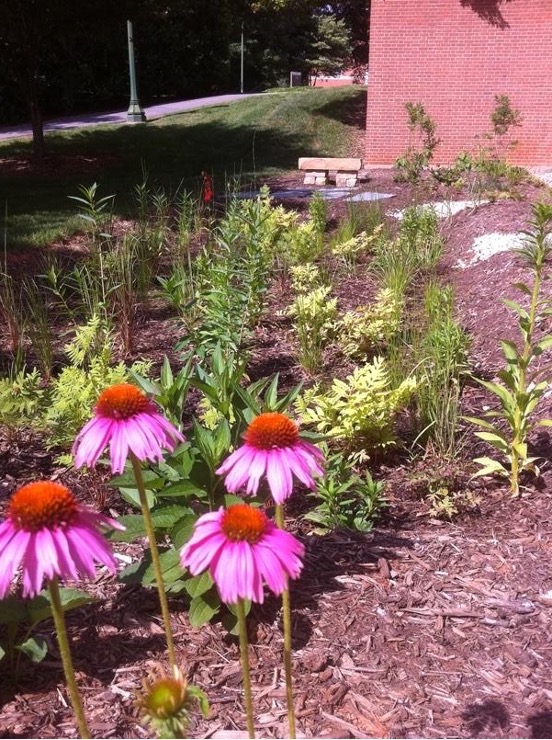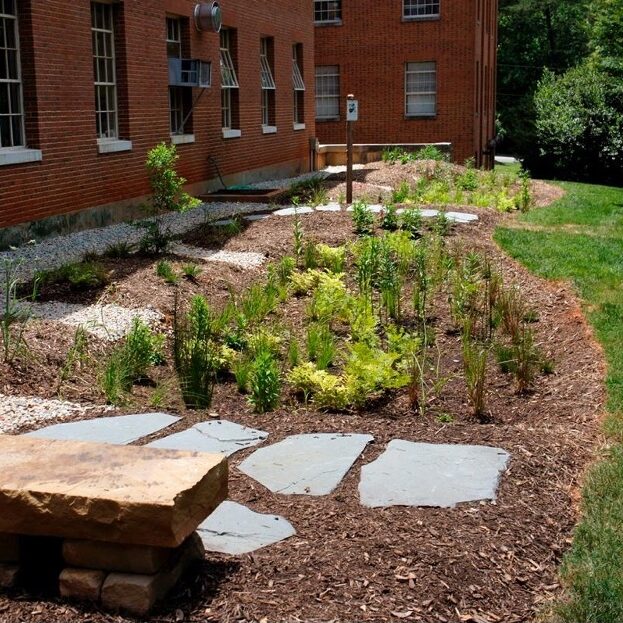‘Not just aesthetics:’ Landscaping in ‘The Forest’ servers a bigger purpose
Campus landscaping aims to reduce impacts of climate change in Winston-Salem
By: Mollie Maynard, Contributing Writer for the Old Gold & Black
Wake Forest is known for the natural beauty of its campus, but the characteristic landscaping of “The Forest” serves another, bigger purpose: adapting to and combating a rapidly changing climate, including more rain and heavier downpours.
The Campus Master Plan, updated in 2019, includes Wake Forest’s goals for the sustainability of its landscaping. These goals aim at preserving woodlands and integrating stormwater management strategies on campus for a dual purpose — benefitting student experience and reducing the university’s environmental footprint.
“We know climate change is happening, so our strategies…are totally different and totally off beat from before,” said Wake Forest Director of Landscaping Paul Sheff. “We get plants that are going to benefit not just aesthetics but are going to be for the climate.”
Sheff and his team work thoughtfully year-round to maintain the land on the Reynolda campus and on several of Wake Forest’s other properties, including the Graylyn Estate, the University Corporate Center and the Reynolda House. Climate change has forced landscaping efforts such as irrigation systems and planting tactics to adapt to issues arising from warmer temperatures and extreme weather.
The human-caused rise in greenhouse gases over the last three decades has caused a global climate crisis. According to the Environmental Protection Agency (EPA), temperatures are quickly increasing, which creates an atmosphere with the capacity to hold more moisture, which leads to more damage with frequent and intense precipitation. Wake Forest’s campus is not exempt from the detrimental impacts of more intense weather events, including erosion, flooding and water pollution.
The rate of change in our lifestyle is going to be amplified by climate changes. It’s just going to be a crazy 10 years, I think, of seeing really drastic environmental changes.
Dr. Courtney Di Vittorio, Assistant Professor of Engineering
“When we talk about what’s the greatest threat [to our campus], it’s stronger storms,” said Brian Cohen, assistant director for sustainability engagement in the Office of Sustainability.
Sheff, who has been at Wake Forest for 39 years, has seen the strength of these storms increase substantially.
“We used to have mild rains where it just rained subtly,” Sheff said. “Now we have downpours.”
On Oct. 20 around 5 p.m., an intense storm with high winds came to Winston-Salem for about 15 minutes as Homecoming festivities were about to kick off on campus. The unpredicted storm hit the city less than half an hour after the Raleigh National Weather Service issued a special weather statement about 30 mph winds and the possibility of hail.
Heavier rains create more stormwater runoff, which erode the land and carry pollutants into water sources, according to the EPA. The landscaping and facilities departments deal with this runoff and prevent it from having negative effects on campus.
“A huge pain point with stormwater infrastructure is there’s not a whole lot you can do with existing development,” said Assistant Professor of Engineering Dr. Courtney Di Vittorio. “Wake Forest is very progressive compared to the rest of Winston-Salem in terms of what they’re doing to reduce runoff during these heavy storms.”
The Campus Master Plan pledges the university’s commitment to providing good stewardship by reducing stormwater runoff, although the city does not formally require it. Part of the strategy is finding solutions to existing infrastructure problems.
Runoff from the roofline of Winston Hall, for example, previously caused erosion in the hillside behind the building and contained copper particles that killed grass. The addition of rain gardens on campus, like the one behind Winston Hall, slows down and filters stormwater runoff, which prevents erosion and pollution while allowing space for flowers and butterfly bushes.


The rain garden beside Winston Hall takes in copper runoff from the building’s roof. (Courtesy of David Davis, Manager of Landscaping Services in Facilities & Campus Services).
Director of Facilities Operations Steve Adams said the university is doing well with its stormwater containment measures, which are designed to handle “worst case scenarios” and can adapt to increasing storm intensity.
Automated irrigation systems on campus are connected to a “weather station” which shuts off sprinklers during significant rains, cutting back on excessive water use, according to Sheff.
“The less [water] we can use, the better,” Cohen said.
The landscaping department also makes a concerted effort to incorporate native plants on campus, which promotes the overall health of the campus ecosystem and functions as an integrated pest management strategy. This means plants can thrive with minimal maintenance and limited use of pesticides and other chemicals that are harmful to the environment.
University Arborist Jim Mussetter said strategically planting trees in locations to minimize root damage is especially important with new construction. According to Mussetter, forested areas surrounding campus contribute to the university’s 40% canopy cover, but construction projects like the Porter Byrum Welcome Center and the athletic facilities have caused significant tree loss in recent years.
“Our goal is 1-to-1 replacement,” Mussetter said. “Since 2014, we’ve planted 800 trees.”
Mussetter and his team work hard to care for “The Forest,” and the specific guidelines for maintaining a sustainable and beautiful campus amid the climate crisis are outlined in the WFU Campus Tree Care Plan. Because of the combined efforts of the landscaping and facilities teams, the university still comes to life during the fall when vibrant foliage creates a colorful canopy across Reynolda campus.
“The rate of change in our lifestyle is going to be amplified by climate changes,” Di Vittorio said. “It’s just going to be a crazy 10 years, I think, of seeing really drastic environmental changes.”
This article was originally published in the Old Gold & Black.
